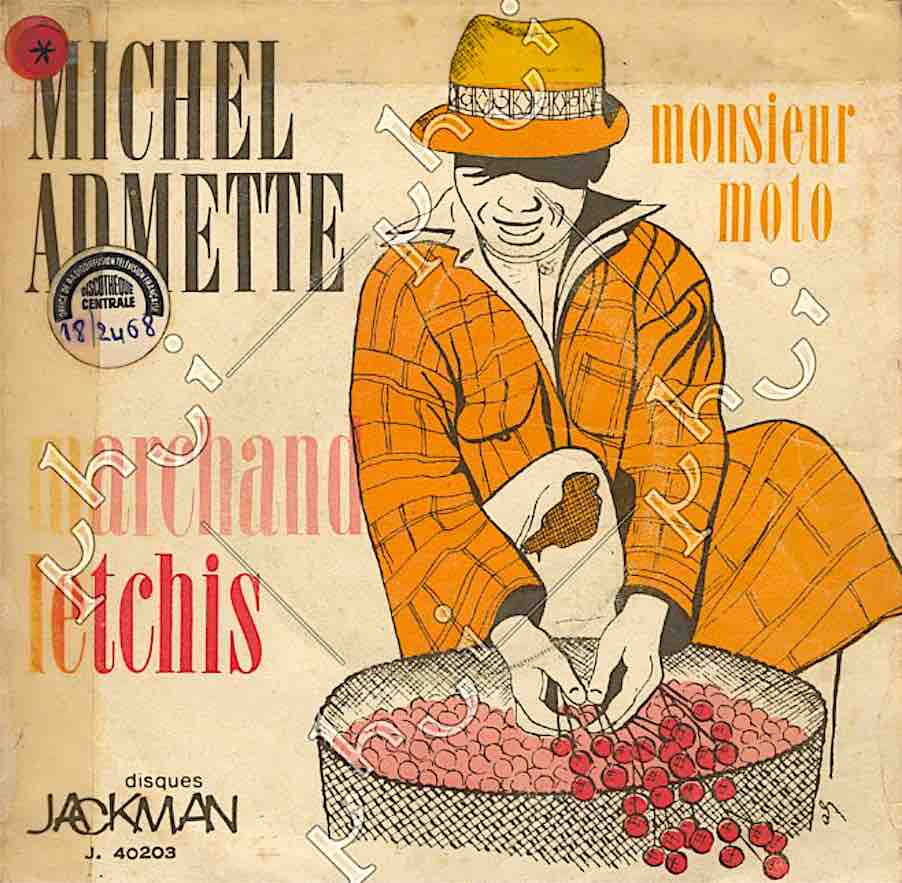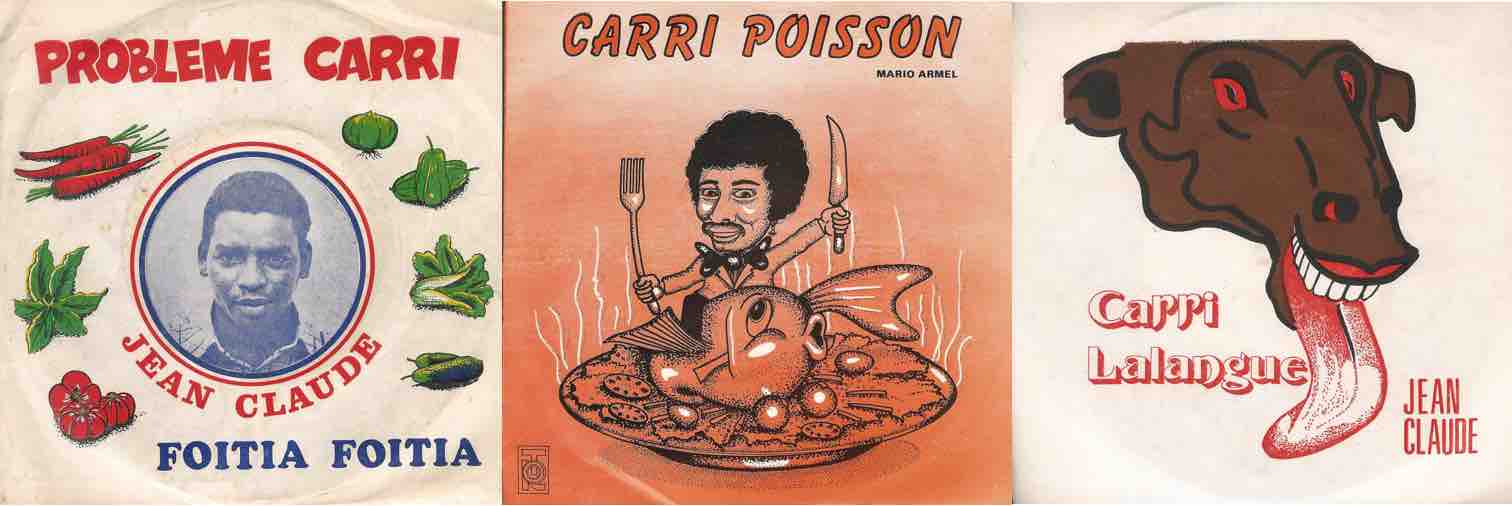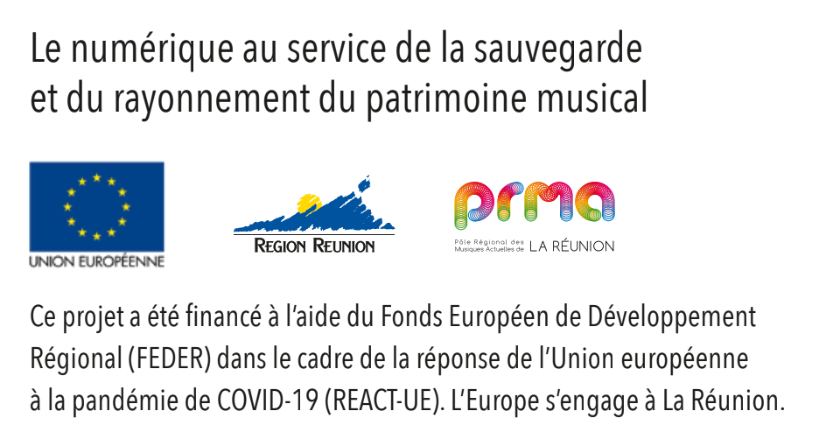Dear friend and reader, beware! The following lines can have two effects on you: either zot bous i fé dlo, ("your mouth waters"), or you will feel ragoulé (“full”, “sated”, “almost disgusted”) because we are going to talk about a subject – if not “the” subject – of the utmost importance: eating.
Reunion music
The singing pots and pans of Reunion
published by
David Chassagne
19 October 2023

Food is a recurring theme in Reunion’s music. And despite appearances, while local musicians know how to sing for their supper, it's not just for fun but because through food we touch the heart of Reunion’s identity. Just like music, food embodies an art of living that is as tasty and flavourful as it is political, economic, and social.
So it is not at all surprising that without much effort, we can curate an almost indigest-causing list of songs whose titles take inspiration from the island’s dishes. We start with almost every possible cari imaginable: Bringèle (“aubergine”; Michel Admette), Langouste (“lobster”; Jean-Marc Pounoussamy), Ti muzo (“small snout”; Maperine), and Bichiques (“goby fry”; Ignatius Almar) are just a few examples. As sides dishes, we have Bouillon brèdes (“leafy greens broth”; Jean Albany/Jules Arlanda, sung by Maxime Laope), and Piments bien forts (“very hot peppers”; Michou) to spice things up, unless you prefer Tit queue la morue (“little cod tail”; Joel Manglou). If you opt for a sweet treat you have Bonbon banane (“banana fritters”; Titi and New Air), Bonbon coco (“coconut candy”; Jules Arlanda), Canne mapou (“Mapou sugar cane”; Georges Fourcade–Jules Fossy), Gouyaviers par pintes ou Grillées pistaches (“a measure of strawberry guavas or roasted peanuts”; Louis Jessu-Jules Arlanda) ... Of course this is just a tasting platter.
 Bouillon brèdes, interprété par Maxime Laope (Lahope) et le Club Rythmique, extrait du 45 Tours Jackman 40225.
Bouillon brèdes, interprété par Maxime Laope (Lahope) et le Club Rythmique, extrait du 45 Tours Jackman 40225. The “meal” seems to be going well: since song (especially sega) is a record of daily life, we sing about food because it is part of our delights, desires, and days. Nor does anyone shy away from sanctifying it with an unbridled sense of humour, like in the hit song "L’assassin" which Jean-Paul Volnay released in 1993 and initially intended just to "fill a gap" on the recording. It takes a phrase that his father sang to him, and in three minutes hastily dresses it up with fourteen Creole dishes. The result is that it is now a crime to put turmeric in the dish brèdes mouroum despite anyone really knowing why. Henri Madoré also had fun playing with the sound of Coca-Cola and Cacolac, the brand name of two drinks that have nothing to do with local Creole culture, just like Luc Donat enjoyed the full-bodied rhyme Boucané, cheminée (“smoked pork, fireplace”).
 Cari bringèle, interprété par Michel Admette, extrait du 45 Tours Affejee AFJ 103.
Cari bringèle, interprété par Michel Admette, extrait du 45 Tours Affejee AFJ 103. But, as we say in Reunion Creole, i zoué pa èk manzé, ("we don't play with food"), and when food finds itself in songs, it's also because, consciously or not, it deals with the rough edges of the Creole soul.
 Bicique la Rose, interprété par Les Jokarys, extraits du 45 Tours Jackman 40112.
Bicique la Rose, interprété par Les Jokarys, extraits du 45 Tours Jackman 40112. The repertoire of the group Baster is very enlightening in this respect. For a start, the manzé (food) that lead vocalist Thierry Gauliris sings about is filled with nostalgia. Mèt un pé de riz au feu, un rougail sounouk si côté (“Put some rice on the stove, a rougail sonouk on the side”), we hear in Mang salé (“savoury food”), while “le samedi nou té sava rode tamarin, avec sa nou té fé in lo sucré“ (“On Saturdays we searched for tamarind, we made a drink with it”), while the adults made a cake in the kitchen (Marmay lontan). But it is also a vector, a marker of proclaimed identity: Moin la bezoin kiltir mon péi, manioc patate do ri mayé pou nou manzé (“I need my island’s culture; cassava, sweet potato, rice and maize to eat”; Mon lémé), Mwin la bezwin la tèr po plant maniok, po plant patat, plant do riz mayi, mon bousé manzé (“I need some land to plant cassava, to plant sweet potato, to plant rice and maize, my morsel of food”; Bibizako). Here we’re at the heart of the matter, with food as the main ingredient, unifying a Reunion-ness that stems from a melting pot of diversity. And that’s exactly what the group Lindigo also sang about – thirty years after Baster – with Kosa nena dan marmit' la (“What’s in the cooking pot?”). The cover art of this track shows a smoking volcano, almost as if Reunion was a giant pan full of smells, flavours, and conviviality.
 Canne mapou, interprété par Les Jokarys, extrait du 45 Tours Dindar 25 014.
Canne mapou, interprété par Les Jokarys, extrait du 45 Tours Dindar 25 014. This convivial atmosphere was perfectly summed up in another hit song: Pic-Nic chemin volcan (“Picnic on the road to the volcano“) by Ousanousava, where, around pots and pans filled with zembrocal, rougail saucisses, cari volaille (“turmeric rice, sausage stew, chicken cari"), the whole family gathers to eat outdoors, in the highlands of Reunion, where traditions stand the test of time. With just a few stanzas, the song is an anthem to creoleness, and which, when listened to now, has a whiff of nostalgia. Other evocative memories are those inspired by the lyrics In ti liqueur Marie Brizard en compagnie d’un pâté créole (“a dram of Marie Brizard with a Creole pie”) sung by Ousanousava (in this case lead vocalist Frédéric Joron), in the hit song Grand-mère (“grandmother”).
Singing about food obviously means setting to music the people without whom the manzé would not be possible: those who produce the food. Countless songs pay tribute to the gruelling job of sugar cane planter or cutter, as well as fishermen (e.g. Pêcheur Terre-Sainte (“Terre-Sainte fisherman”) by Ousanousava, and Mon mari pêcheur (“my fisherman husband”) by Jules Fossy and Georges Fourcade) and their catches: Bichiques la monté (“the goby fry have swum upstream”) sung by Marie-Armande and Henry-Claude Moutou, Pierrette Payet or Michel Admette).
 Gouyaviers par pinte, interprété par Marie-Armande et Henry-Claude Moutou et l'orchestre les Play-Boys - extrait du 45 Tours Soredisc 20 026.
Gouyaviers par pinte, interprété par Marie-Armande et Henry-Claude Moutou et l'orchestre les Play-Boys - extrait du 45 Tours Soredisc 20 026. Then there’s also the places where food is bought and sold: the bazar (“farmer’s market”) and the boutique chinois (“Chinese shop”). It was dan milieu bazar ("at the market") that Lisa lost her z’anneau: Rend z’anneau là Lisa (“give the ring back, Lisa”, first sung in the 1950s by Benoîte Boulard and Raymond Aliqui). It is also en sortant ti bazar ("on leaving the market") that Pierrot Vidot falls under the spell of a mysterious stranger, whose beauty he describes with the help of some “tasteful” references: Toué lé jolie, ton dent lé blanc comm’ de riz... ton zié brille comm’grain letchis (“You’re pretty, your teeth are white like rice... your eyes shine like lychee stones”).
 Problème cari, interprété par Isabelle et Yolaine Zemia, extrait du 45 Tours 830446.
Problème cari, interprété par Isabelle et Yolaine Zemia, extrait du 45 Tours 830446. As for the shop, that’s where Chinois i vend la liqueur ("the Chinaman sells liquor"), sang Williams Justine, while Jeanine and Les Piros belt out a scathing Chinois rend mon monnaie ("Chinaman, give me my change") just after buying deux kilos zareng ("two kilos of herring").
But food is also about economics, and if we sing about food, it's because having it or not is the first sign of wealth or poverty. Sak nana la pou gaté sak la point la point du tout ("Those who have it, have so much that it rots; those who have nothing, have nothing at all"), sang Françoise Guimbert in Sak la poin (“those who have nothing”). Many years earlier, in La Rosée Tombé (“Fallen dew”), Maxime Laope sang: La case mon monmon mi mange cari la volaille, la case chinois là waya, mi mange le rein sounouk (“At my mother’s house I eat chicken cari, at the Chinaman’s place I eat snook full of fish bones”).
 Mme Fin Mizo, interprété par Jean-Paul Volnay et les Tropic de Paris, extrait de la cassette Zoli défo, SEDM 0S 44483.
Mme Fin Mizo, interprété par Jean-Paul Volnay et les Tropic de Paris, extrait de la cassette Zoli défo, SEDM 0S 44483. One food for the rich, another food for the poor? Let the songs answer that question. Cod, for example, is always portrayed as fare for the lower classes: Mi comprend pas comment la morue i vend bon marché ("I don't understand how the cod is sold so cheap") we hear in Mon mari pêcheur, or better still: Quand moin sera riche, mi mangera pi la morue ("When I’m rich, I won’t eat cod any more"), declares Jules Joron in the hit song Séga la morue by Ousanousava. As for rice – Reunion’s staple food once the island became a French département in 1946 – it was already a problem in 1975, as Jean-Claude Thévenin sings: Baisse le prix le riz, augmente le prix whisky bann gro blan néna l’argent, nou zenfan la mizère, nou voi l’enfer sur la terre ("Lowering the price of rice, raising the price of whisky, those rich landowners have money, the poor like us have hell on earth"). Half a century later, the refrain still holds true.
Yet it is also through food that we can measure changing times. Thus, in the 1970s, Luc Donat ordered a Cognac Perrier, a sign of a modernised Reunion where Nana l’auto i roule partout, Saint-Denis, Saint Gilles ça la bien changé, Progrès aussi l'amène la télé, Marmaille l'est jeune, L'a d'venu yéyé ("There are cars driving everywhere, Saint-Denis, Saint Gilles have changed a lot, progress has also brought TV, children are young, they’ve become yé-yé"). The Reunion of yesteryear or that of tomorrow? Ultimately it boils down to a question of taste.
 Cognac perrier, interprété par Luc Donat, extrait du 45 Tours Dindar 25 024.
Cognac perrier, interprété par Luc Donat, extrait du 45 Tours Dindar 25 024. Let’s finish with a little gem, gleaned from track No. 5 of one of the outstanding albums of the 2000s, Cilaos, by the singer Iza. For just 29 seconds, you hear the "touc touc" of a calou (pestle) pounding a pilon (mortar), then the click-clack of a spoon against a plate, the "hiiiisss" of oil at the bottom of a hot pan, and finally the sound of the lid being gently closed. This is what we've been telling you all along: here, the pots and pans sing. And always in tune.

In Mauritius too...
Digging through recordings of Reunion’s music inevitably brings up tracks from Mauritius, where food is also part of the repertoire. The hits Alouda limonade and Cari ourit coulère socolat by Cyril Labonne, or Brède Mouroum by Yoko are just a few examples. And of course there’s Jean-Claude Gaspard's Problème carri, where choosing the carri becomes an almost existential question!
 Alouda limonade interprété par Ciryl Labonne extrait du 33 Tours Jackman LPJ 177.
Alouda limonade interprété par Ciryl Labonne extrait du 33 Tours Jackman LPJ 177. David Chassagne
Traduction réalisée par Catharine Cellier-Smart (Smart Translate).
Bonus
 Carri canard, par Daniel Vabois, extrait du 33 Tours Z'histoires créoles Auvidis PFAV 4002.
Carri canard, par Daniel Vabois, extrait du 33 Tours Z'histoires créoles Auvidis PFAV 4002. 
